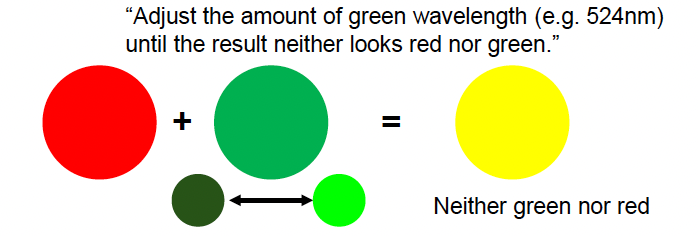Color vision
1/75
There's no tags or description
Looks like no tags are added yet.
Name | Mastery | Learn | Test | Matching | Spaced |
|---|
No study sessions yet.
76 Terms
visible light to human
opsin+retinal within human photoreceptor can only absorb wavelength between 390nm -760nm
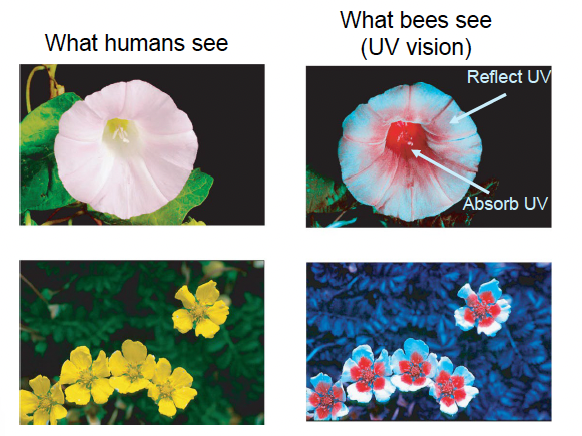
other animals can absorb other wavelengths → see wavelengths that humans cannot
What is the limiting factor for vision color?
Vision is possible because the opsins react to electromagnetic energy that enters the eye
how can electromagnetic energy enter the eye?
by illumination and reflectance
illumination
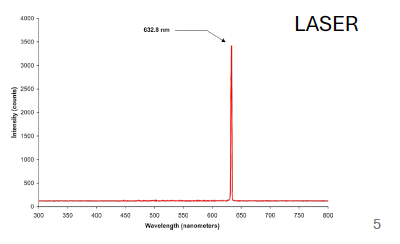
illuminants produce electromagnetic radiation
monochromatic light source: one single wavelength is produced:
laser
light emitting diodes (LEDs)
sodium lamp (589nm)
polychromatic light source: multiple wavelengths are produced
the sun
light bulbs
candlelight
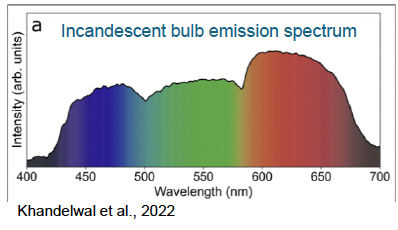
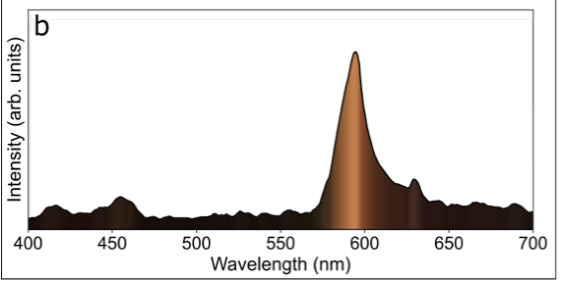
reflection, transmission and absorption
When electromagnetic energy hits an object, it can either be absorbed, transmitted or reflected.
Wavelengths absorbed by the material pigments do not enter the eye
Color vision is NOT determined by the absorbed wavelengths.
Only wavelengths that are either transmitted or reflected enter the eye to cause vision
Color vision IS determined only by transmitted or reflected wavelengths.
Absorption and reflection are vary between 0% to 100%.
Incident light that is not absorbed will be reflected, transmitted or scattered.
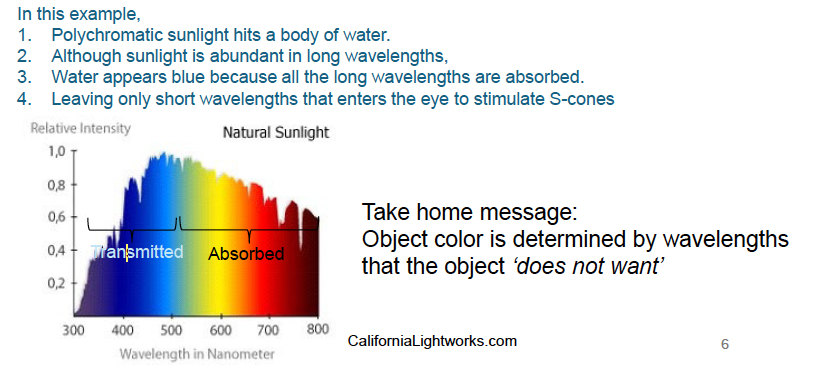
what determine color?
Color is determined by the electromagnetic wavelengths
entering the eye and
causing photoreceptor reaction
additive color
color perception caused by wavelengths added together by illuminants that produce electromagnetic radiation of wavelength
subtractive color
Color perception caused by wavelengths being subtracted out by materials that do NOT produce electromagenetic radiation
→ they absorb wavelengths instead and those wavelengths are subtracted out → does not enter the eye
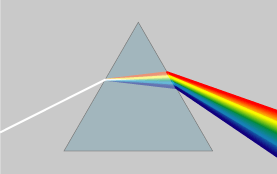
refraction
Concept:
Shorter wavelengths refract (bend) more
Longer wavelengths refract (bend) less
when passing into a medium of different refractive index.
This is how a prism splits white light:
a mixture of all sorts of wavelengths between 400-760nm
into its component colors of the rainbow.
This is why red is always at the top of rainbows (bc of longest wavelength - bend the least)
And blue at the bottom. (shortest wavelength - bend the most)

what happen when light pass thru a refracting instrument?
any lens system is a 2 prism stacked upside down → can be seen as a refracting instrument
When polychromatic light pass through the eye (or any other lens):
Long wavelengths converge farther behind the lens than short wavelengths.
Only one wavelength can be brought into focus at any point.
All other out-of-focus wavelengths cause blur.
chromatic aberration
the blurring caused by all the wavelengths that does not focus on the retina
Chromatic blur from chromatic aberration is inherent to every single eye.
There is no way around it.

the range and intensities of wavelengths entering the eye and causing photoreceptor reaction depends on what?
the type of illumination
materials in the environment
refraction in the anterior segment
opsin sensitivity
distinction between electromagnetic wavelength and color
Color is not synonymous w electromagnetic wavelength
Electromagnetic wavelengths are physically quantifiable
Colors are subjective, immaterial, perceptual constructs of our minds
There is no such thing as color in the world (bc every species/individuals perceive colors differently)
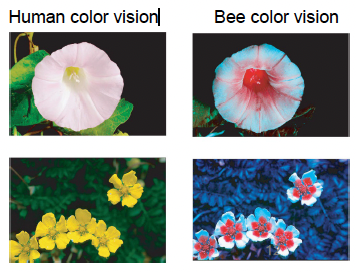
Color vision
Color vision: ability to make discriminations based solely on spectral content (the chromatic info at different wavelengths)
color attributes
hue: the color — red, orange, yellow
saturation (chroma): describes the amt of colordness vs whiteness (đậm hay lợt)
brightess (value): the relative lightness or darkness of the color (tối hay sáng)
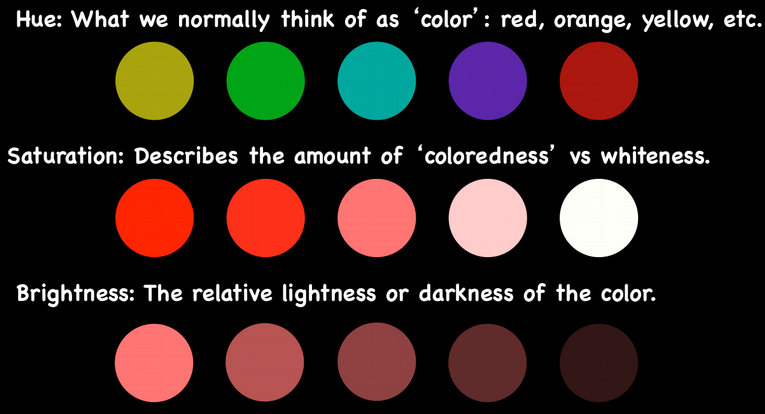
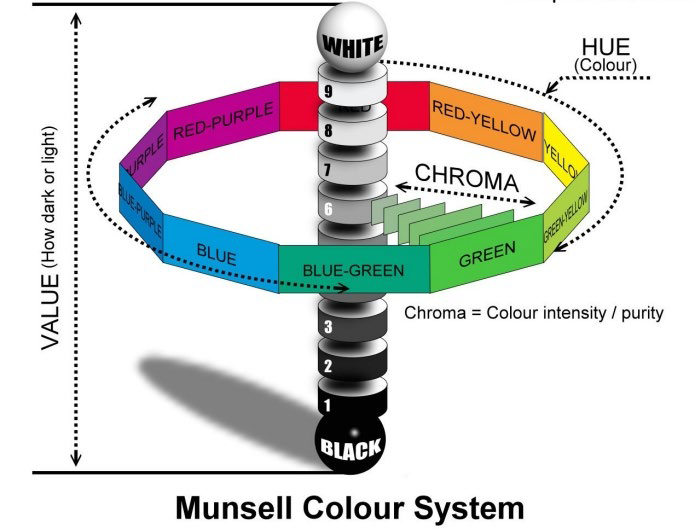
Munsell’s color tree
Problems with the Munsell Tree:
Only describes perception
No relationship to the physical causative agent (electromagnetic radiation)
No way to know how to produce or reproduce a color
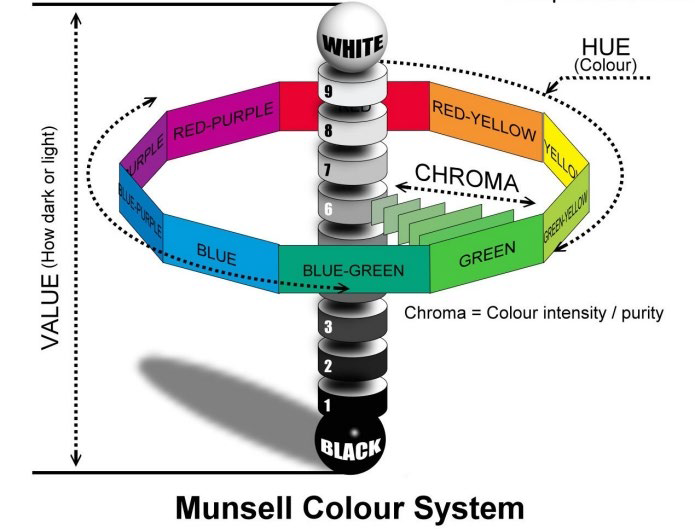
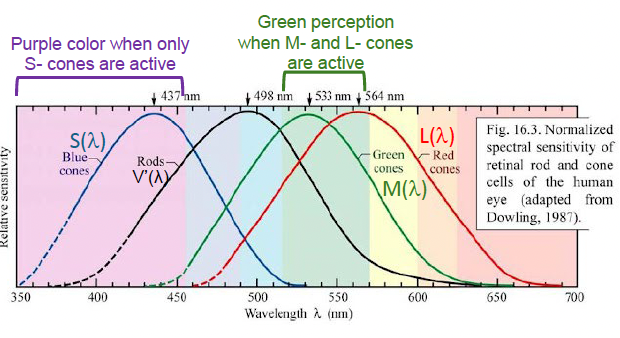
all vision perceptions starts w photoreceptors
color vision starts w cone activity
What determines the relationship between electromagnetic radiation and subjective brightness of color?
The relationship between:
The physical electromagnetic radiation, and
The subjective brightness of color / sensitivity
is given by the luminosity function.
The luminosity function describes spectral sensitivity
of human observers
Does wavelength determine color perception?
Wavelength does not determine color perception.
It is the relative activity of each cone type that determines color.
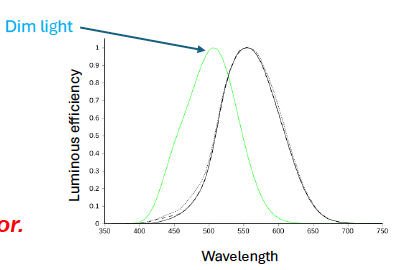
What affect cone response?
Cone response is both dependent on wavelength and intensity.
peak sensitivity of opsin at around 550nm (the most abundant wavelength on earth)
in human, 550nm is limey-green
also absorb similar wavelength but lesser extents
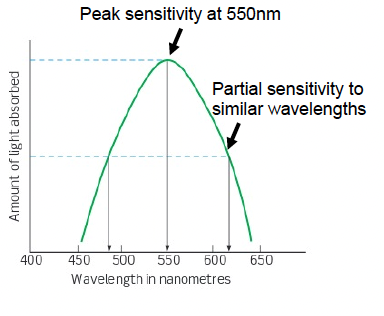
the relationship between light absorption and phototransduction
proportional (tỉ lệ thuận)
More light absorbed → more signal.
Less light absorbed → less signal.
→ opsins absorption and visual signaling is wavelength dependent.
How does light intensity affect opsins absorption and visual signaling?
Less light (e.g. evening / nighttime): less light to absorb → less signal.
More light (e.g. noontime): more light to absorb → more signal.
problem w being dependent on both wavelength and intensity
given: photoreceptor activity is 100% at 550nm = 100 photons of a 550nm light are absorbed by opsin
given: photoreceptor activity is 50% for 620nm and 480nm = only 50 photons is absorbed for every 100 photons of light
→ difficult to determine if the activity is from 620nm or 480nm
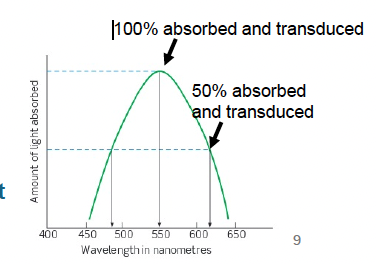
so if we have 200 photons (increase light intensity), we will see 100 photons absorbed.
→ difficult to determine how many photons are absorbed by each wavelength
could be absorbed by 550nm, 480nm, or 620nm.
therefore, activity from one type of photoreceptor alone cannot distinguish wavelength from intensity differences!!
can we distinguish light wavelength and intensity differences based on one type of photoreceptor activity?
no because we simply cannot tell how many photons are absorbed by which wavelength
the principle of univariance
uni-: one ; -variance: variable
we cannot tell intensity differences from wavelength differences at night when ONLY rod are active because:
rods activity is excited by the amount of photon it absorbs only, so:
A short-wavelength (blue) light that causes the receptor to absorb 10 photons will produce the exact same response as a long-wavelength (red) light that also causes the receptor to absorb 10 photons.
👉 Same number of absorbed photons = same response, even if the wavelengths are different. So we cannot tell the wavelength of the light that excite rod cell based on its activity .
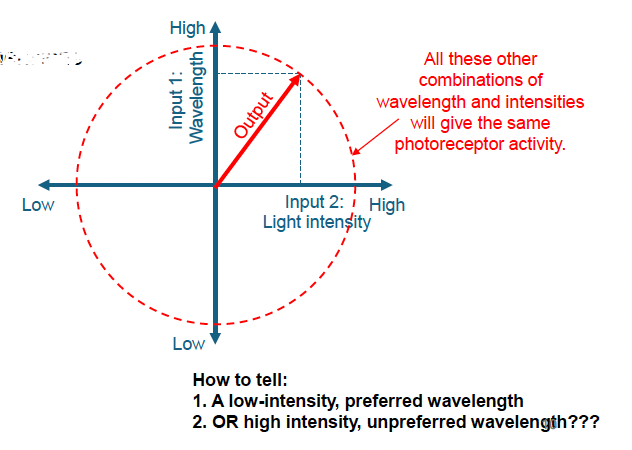
dichromatic vision
di-: two , -chromatic: color = two-cone vision
Given 2 cones with different peak sensitivity, at 450nm and 620nm.
100 photons at 480nm will cause:
• 50 photons to be absorbed and 50 units of activity in the 550nm preferring cone
• 90 photons to be absorbed and 90 units of activity in the 450nm preferring cone
100 photons at 620nm will cause:
• 50 photons to be absorbed and 50 units of activity in the 550nm preferring cone
• 0 photons to be absorbed and 0 units of activity in the 450nm preferring cone
therefore,
We can now disentangle wavelength confusions by looking at the activity of the second cone type.
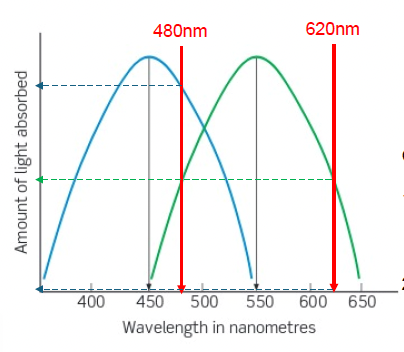
Dichromatic vision with intensity light
Given: 200 photons at 480nm:
100 photons to be absorbed and 100 units of activity in the 550nm cone
180 photons to be absorbed and 180 units of activity in the 450nm (preferring cone)
For 100 photons at 550nm:
100 photons to be absorbed and 100 units of activity in the 550nm preferring cone
0 photons to be absorbed and 0 units of activity in the 450nm (preferring cone)
Therefore, we can also disentangle wavelength + intensity confusions
by looking at the activity of the second cone type.
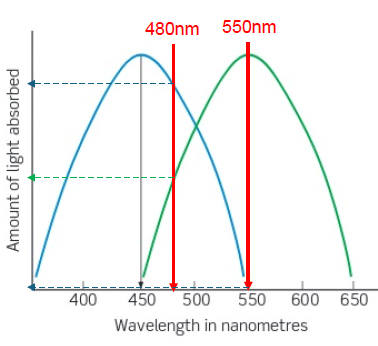
Limitation of dichromatic vision
Given: 100 photons at 550nm:
100 photons to be absorbed and 100 units of activity in the long wavelength cone
0 photons to be absorbed and 0 units of activity in the short wavelength cone
200 photons at 620nm:
100 photons to be absorbed and 100 units of activity in the long wavelength cone
0 photons to be absorbed and 0 units of activity in the short wavelength cone
We still cannot distinguish between 550nm and 620nm.
→ is only helpful when the light has a wavelength that excite both cones

what is the useful range of wavelength for the dichromatic system?
450nm-550nm
wavelengths outside of that range is useless
animals have difficulty distinguishing between non-nutriotious leaves and nutritious fruit.
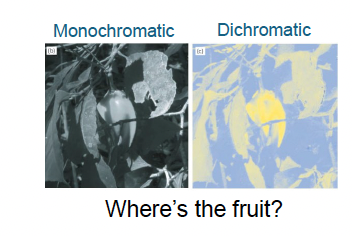
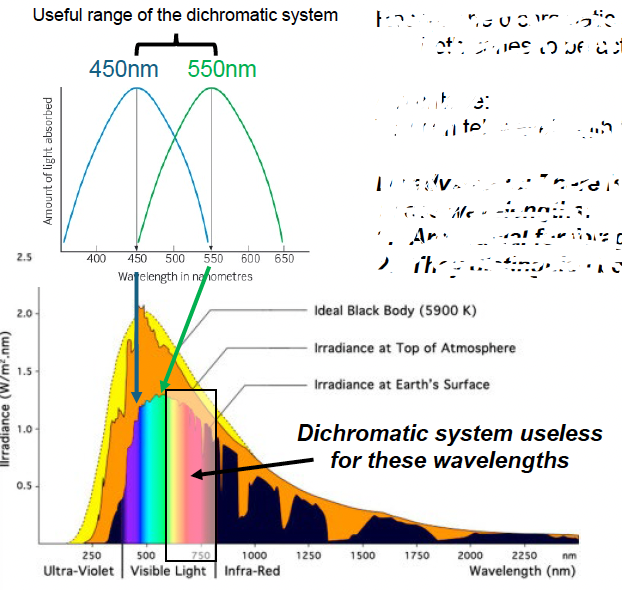
the trichromatic system
evolvement of short wavelength opsin → solution to the dichromatic limitations
explains why M and L-opsins are genetically, biochemically and functionally very similar while S-opsin is very different
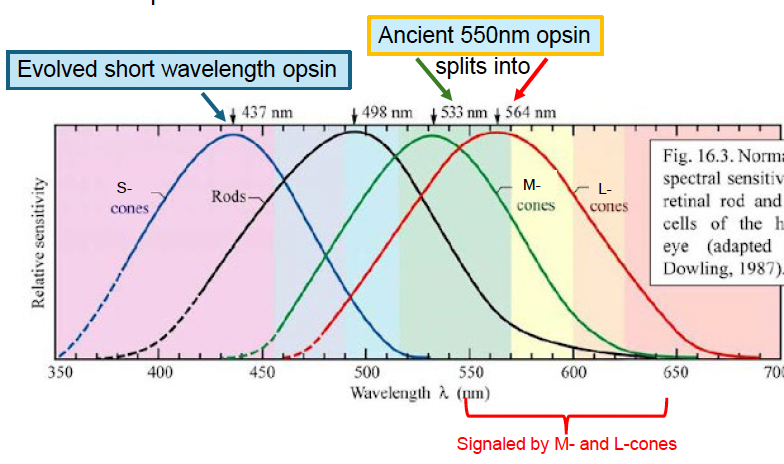
types of opsins
L : long wavelength (peak absorbtion around 550nm)
M : medium wavelength (peak absorbtion around 480nm)
S : short wavelength (peak absorbtion around 420nm)
color vision from the trichromatic system
the color perceived by the eye is the combination of photoreceptor activity from the 3 cone types
all different combinations of wavelengths that initiate the same 3 photoreceptor activity will cause the same perception of color (see attachment)

color metamers
Color metamers are different spectral distributions that cause identical color perception.
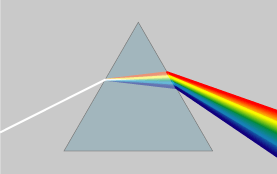
metameric stimuli
wavelengths or a mixtue of wavelengths
appear matched in color
cannot be distinguished from each other
ex: white color can be from red blue green wavelengths entering the eye, or a multitude of wavelengths from sunlight

genetic deficiencies that affect color vision
color vision is enabled by 3 genes encoding for the opsins in 3 cones
defect of these genes will cause vision loss
gene for S cone is autosomal
gene for M and L are sex-linked in the X chromosome
→ males (XY) are more prone to color vision defect
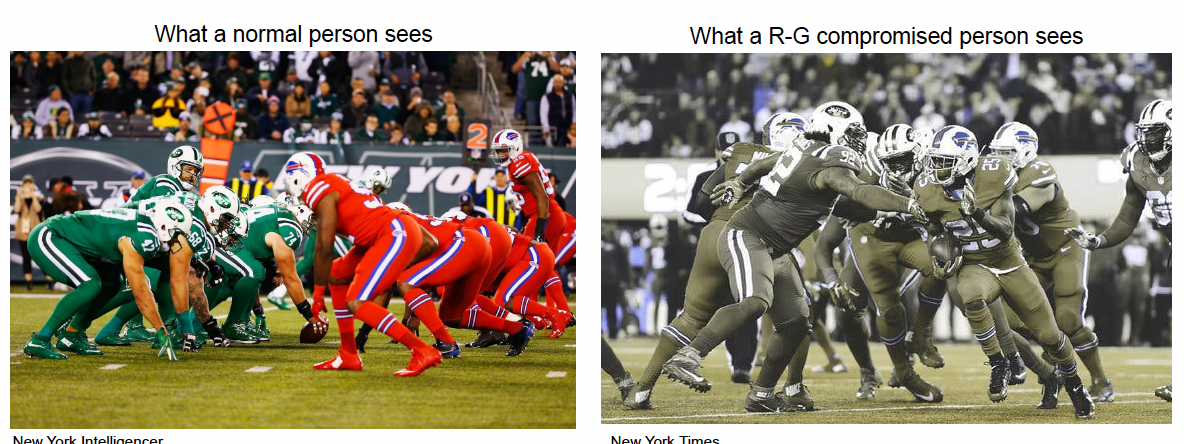
types of inherited color vision deficiencies
monochromacy:
rare
requires 2 genes to be disrupt
grayscale vision
dichromacy:
one gene disrupted
protanopia: no L-cones (1% males)
deuteranopia: no M-cone (1% males)
tritanopia: no S-cones (rare)
anomalous trichromacy
impaired color vision
3 cone types present
more common than dichromacy
protanomaly: 2 M-like cones
deuteranomaly: 2 L-like cones
tritanomaly: reduced S-cone function
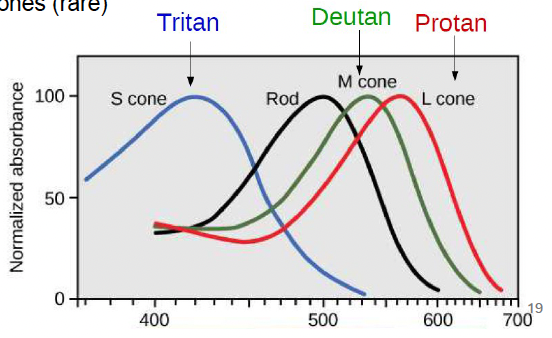
what does vision allow organisms to do?
The purpose of vision is to enable organisms to
Observe the environment
Make appropriate decisions
Behave successfully
Obtain behavioral feedback through more observations
opsin selection pressure
most abundant wavelength on earth’s surface is about 500-600nm
animals develop opsins sensitivity to 550nm to maximize daily life efficiency (easy detection, more info about environmental conditions)
why is the most abundant wavelengths at the earth’s surface between 500-600nm?
the radiaiotn of spectrum of sunlight
reflectance from natural objects on earth (mainly vegetation)
facts
trichromats: animals benefit from 3 cone type color vision
priamtes have trichromacy
majority of diurnal mammals are dichromats (only 2 cone - reduced colot vision)
monochromats (1 cone type - grayscale vision) is RARE, found in a few nocturnal and marine species
nocturnals use only rod vision bc only short wavelengths penetrate water
color matching
combinations of light that appear to be the same color for most people
Mathematical formulas derived from empirical observations
That explain why certain combinations of wavelengths
Cause the same L-, M-S-cone activations
And look the same.

why is color matching useful?
Calculate various combinations of wavelengths that will look identical
Devise alternative combinations of wavelengths to reproduce the same color in different systems
e.g. yellow light bulb vs yellow on the TV vs yellow on print all appear yellow but are caused by very different combinationsofwavelengths
clinical application of matching
nagel anomaloscope — test for anomalous color vision
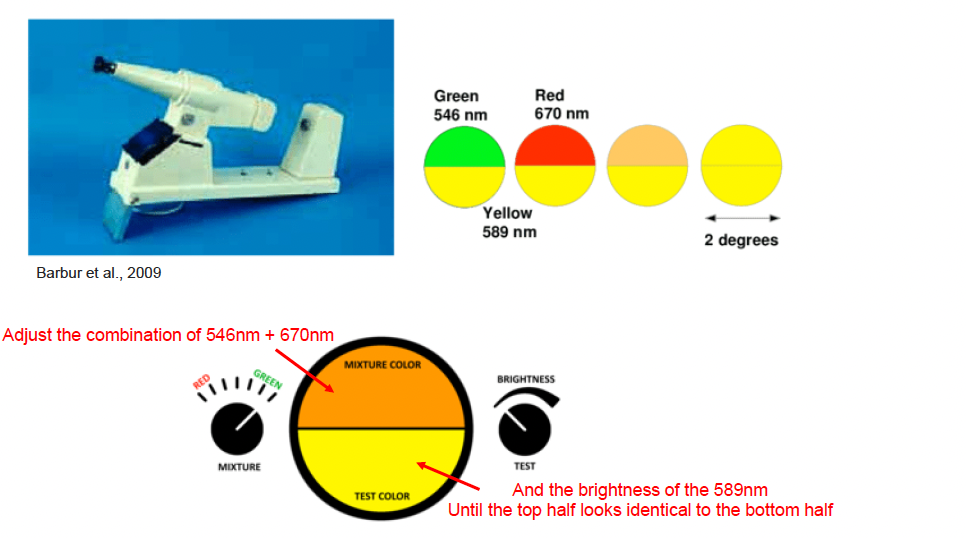
primary colors
since we only depend on cone activity, we don’t need all the wavelengths
most colors derived form wavelength of visible spectrum can be reproduced by adding different amounts of primary colors
primary colors = 630nm, 532nm, 465nm
primary colors do not correspond to the peak wavelengths of the L/M/S cones
primary colors are selected to be primary based on the perceived “pureness” of the hue
they mostly stimulate one cone type each
mixing them in different amounts can make all other colors we can see
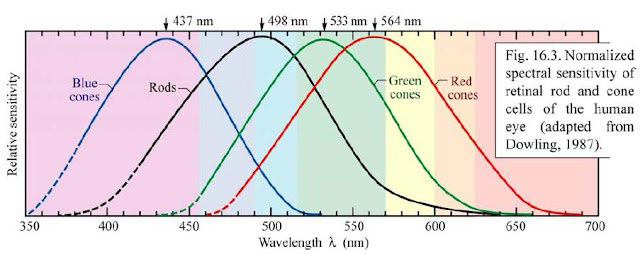
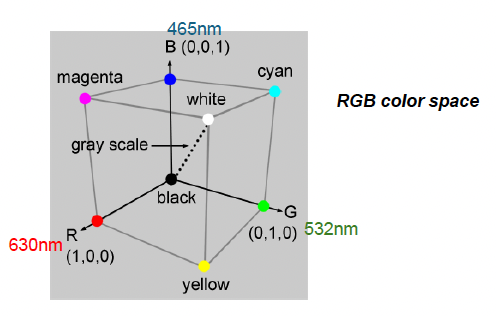
Tristimulus values and color space
The space of all possible colors that can be displayed
by mixing RGB defined a color space
RGB color space — see attachment

characteristics of the CIE 1931 XYZ color space
the boundary of the color space are:
The limits of human hue perception
Elicited by monochromatic wavelengths
bounded by the white outline
white color is called equal energy white —- cordinates [0.33,0.33]
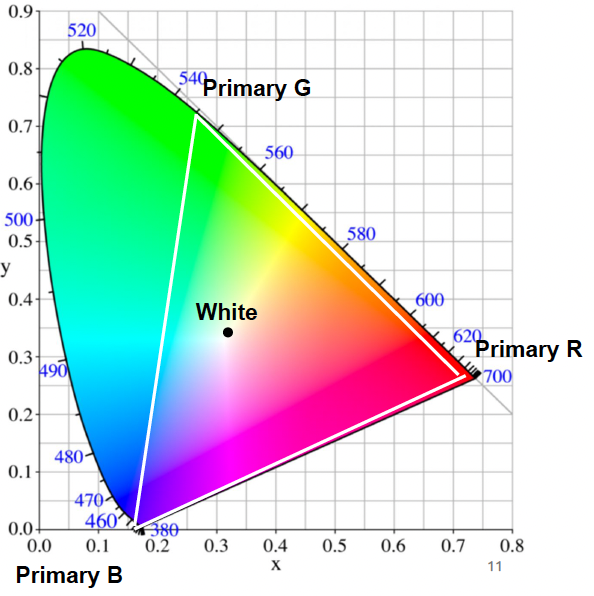
color matching
the process where the observers adjust the RBG until it matches the target color
polychromatic colors
all colors on the line connecting 2 points (colors) on the triangle are produced by mixing those colors
all colors inside the triangle are produced by mixing all 3 RBG colors
how does the CIE 131 XYZ color space better than the Munsell color tree?
by relating perception to wavelength
how is the dominant wavelength of any color measured?
by :
plotting the color coordiantes
connecting a straight line from equal energy white thru the color coordinates
the dominant wavelength is given by the intersection of the line and the boundary of the color space
how to calculate saturation?
measure the distance between:
the white coordinate and the color
white and the dominant wavelength
divide 1 by 2
0 = desaturated (grayscale - no color)
1 = saturated, pure color
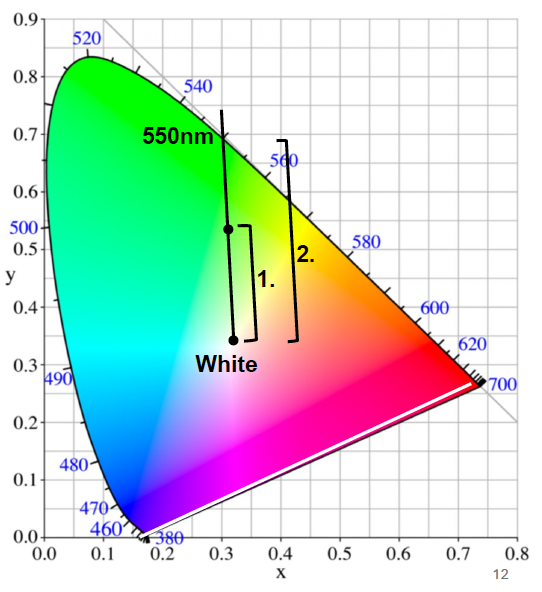
color gamut
the range of reproducible colors
technology cannot display all the colors that humans can perceive
i.e. RGB subspace
manufacturers define their own subspace
common gamuts are in attachment
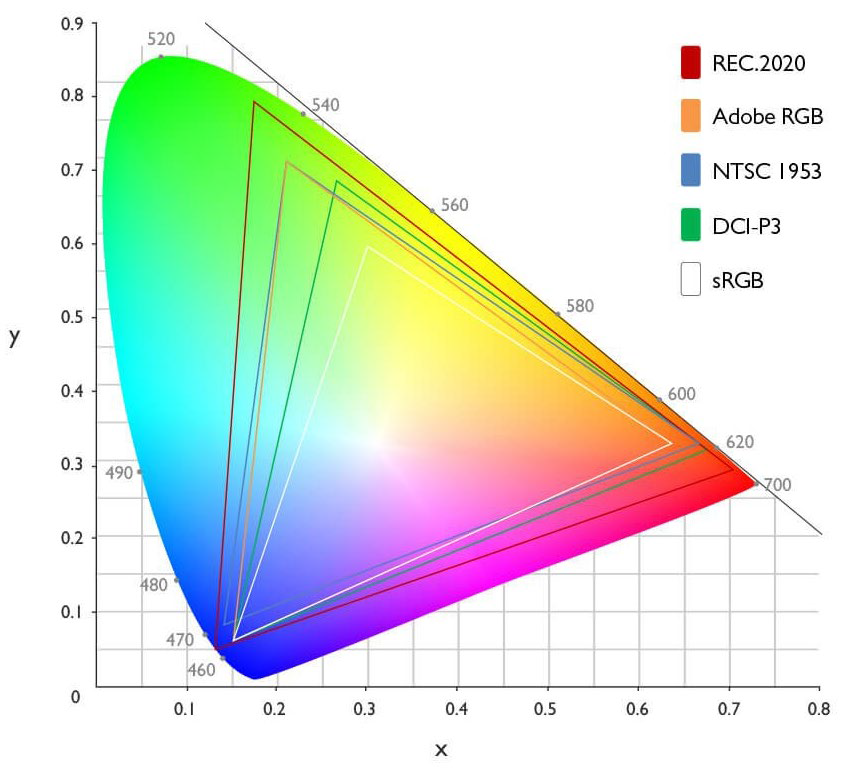
MacAdam Ellipses
he found that some colors are more easily discriminated than others
The MacAdam Ellipses are regions in the color space perceived to be the same color as the center.
colors within an ellipse are indistinguishable — metamers

Color discrimination in humans are:
Best in blue hues
Medium with red hues
Worst with green hues
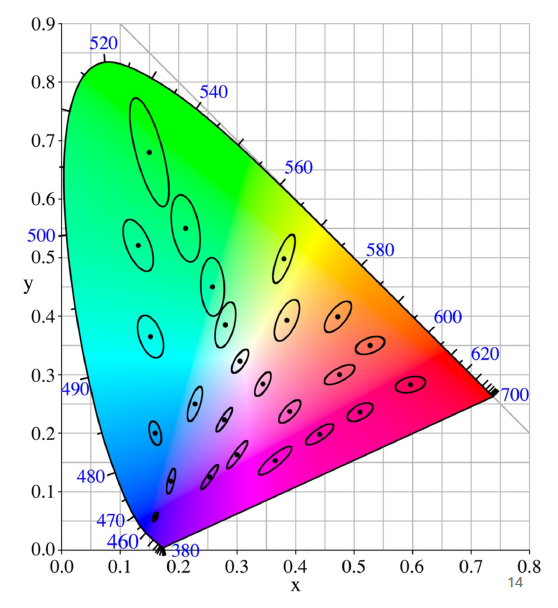
the amount of ellipses show how many different colors we can distinguish at each region
confusion lines and color blindness
The CIE 1931 xy color space also indicates colors that appear the same to colorblind people.
Confusion lines are lines connecting colors that will be mixed-up by a color-blind person.
All colors between two confusion lines appear indistinguishable.
Co-punctal points are where the confusion lines intersect.
For deutans, the intersection is beyond visibility.
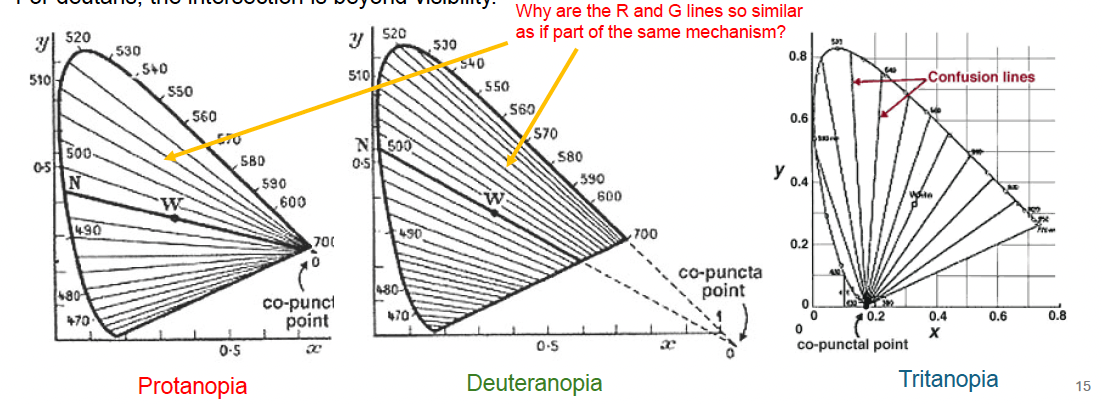
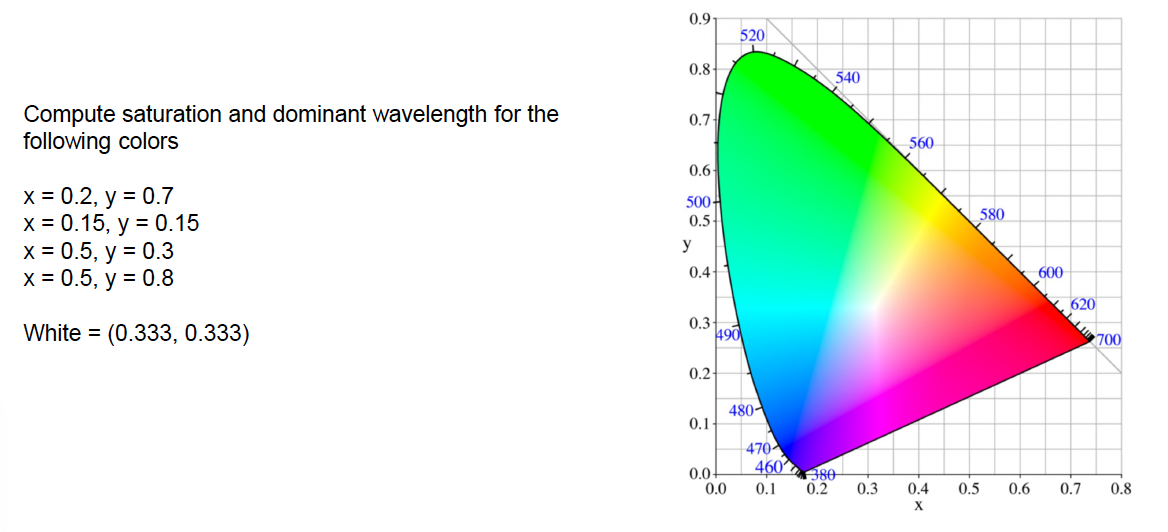
non-spectral colors
these colors do not have a dominant wavelength, can be written as the negative of the complement of the dominant wavelength
color perception organization
organized in three channels :
Red-green axis
Blue-yellow axis
Brightness (not considered further on this lecture)
color opponency
it is not possible to perceive reddish green or blueish yellow
if the given color is red, and a certain amount of green is added to red, when the amount of these 2 colors are balanced, the red and green will completely dissapear
chromatic valence functions
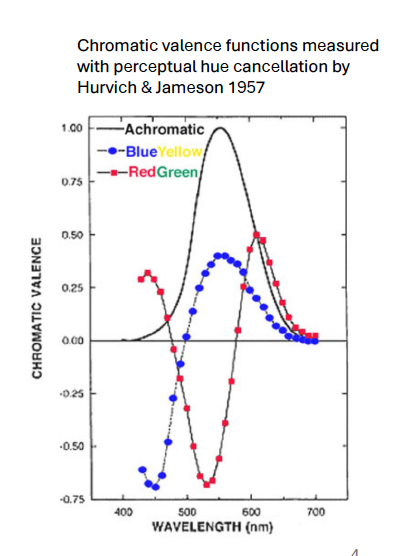
reveal color opponency in human vision and can be measured with with hue cancellation.
For example, pure red is obtained by cancelling the yellow in 700nm light with blue.
